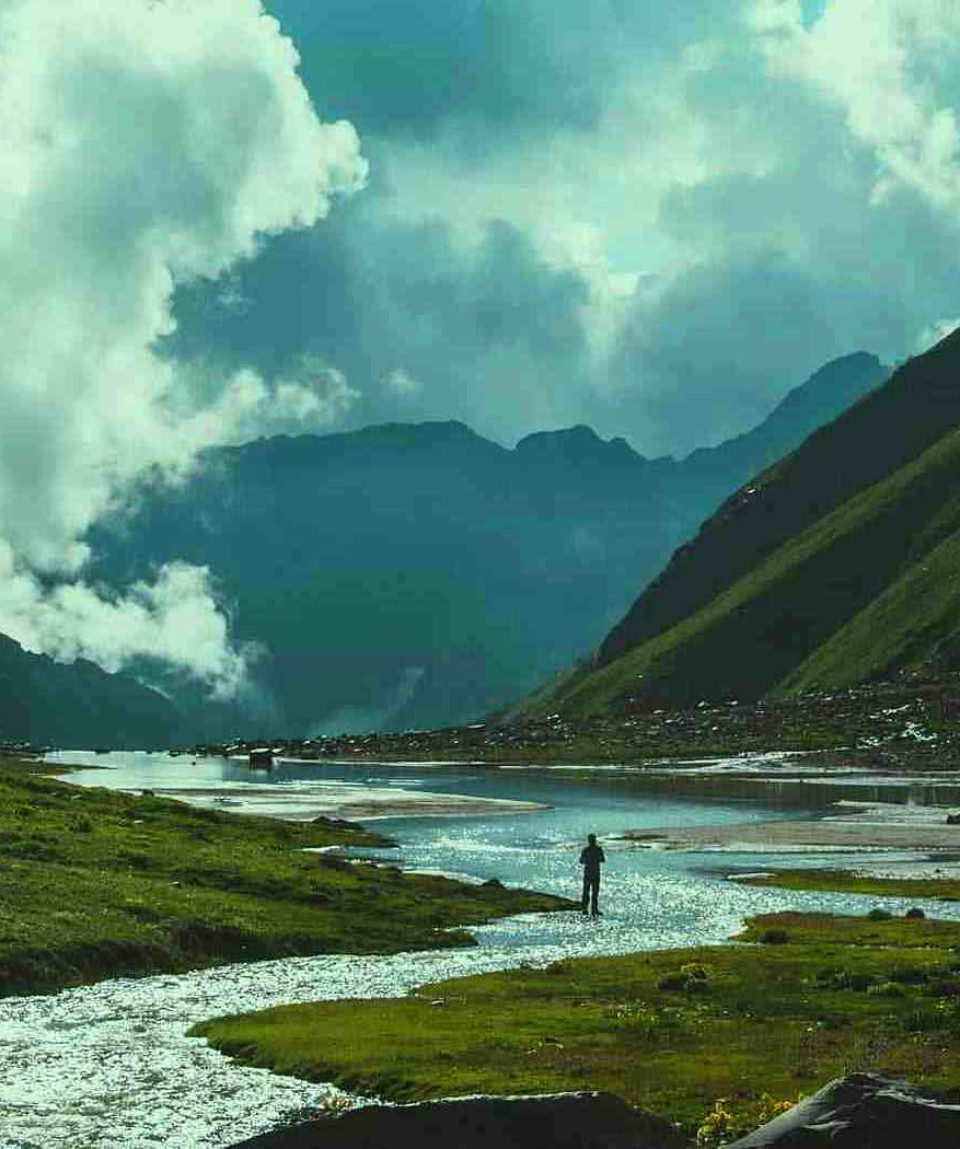Hampta Pass Trek
fromHampta Pass trek lying on the Pir Panjal Range of the Lesser Himalayas. Hampta Pass trek is the queen of all treks, the view from Hampta Pass is unmatched to anything else.
-
Reviews 0 Reviews0/5
-
Vacation Style Holiday Type
-
Activity Level Moderate
-
The most popular and favourite of all Himalayan treks is the Hampta Pass trek of Kullu. Lying on the Pir Panjal range of the Lesser Himalayas, the view from Hampta Pass is unmatched to anything else. A unique view awaits you at Hampta as you literally get to see the two faces of nature. One side of the Pass exposes the infertile barren mountains of Lahaul while the other side displays the verdant dense green valley of Kullu thriving with wildflower growth, making the scene quite dramatic! The trail that takes you to the Hampta corridor is no less dramatic, filled with pine, birch, and rhododendron forests, glacial rivers and streams, beautiful meadows . The trek to Hampta Pass is the queen of all treks.
The best time to go Hampta Pass trekking is between June to September when the climate is perfectly suitable. Moderately warm temperatures and bearably cold nights make the trek experience relatively easy for beginners. While June still remains heavily snowy, September sees the Valley come alive with a burst of sprightly flowers. A number of peaks of the Lesser Himalayan range like the Deo Tibba and Indrasan Peak are visible from the Pass as well as other campsites. Another popular trek that trekkers usually pair with Hampta is the Chandratal Trek in Lahaul and Spiti. Chandratal is a crescent shaped glacial lake which is about 35 kms away from Hampta Pass and literally means the ‘Lake of the Moon’. The vast stretch of meadows by the banks used to be grazing lands for herds of sheep and is now home to quite a few endemic animals and birds species.The transparent glass-like water of the lake against the backdrop of the mountains makes for a stunning sight. The mesmerizing views gathered during the whole trek will be one of the best additions to your treasure of memories.
- Transport Facility from Manali to Jobra
- All Forest Permits and Entrance Fees
- Accommodation in tents on double and triple sharing
- All meals: Breakfast, packed lunch, tea, coffee, snacks, soup and dinner (Day 1 Dinner to day 5 Breakfast)
- Trek necessities and equipments: sleeping bag, mattress, liners, pillows, dining tent and kitchen team, comfortable tents, crampons and gaiters
- Separate accommodation for toilets for males and females
- First aid medical kits and oxygen cylinder
- Experienced and qualified professional trek guide and support staff
- Helpers, and mules
- Breakfast and lunch on the first day
- Lunch and dinner on the last day
- Personal insurance and medical certificate
- Individual toiletries and medicine kits
- Porters or mules for carrying personal luggage
- Any expenses borne by trekker on their own
- Train or Flight tickets charges
- 5% GST
- Anything not mentioned in Inclusions
The best time to do the Hampta Pass trek is between the months of June to September. This is the most enjoyable time as the climate remains pleasant and cheerful. Temperatures hover between 13 to 18 degree Celsius in the day and drop to almost 0 at night. June sees a lot of snow because of the lack of adequate sunlight in the narrow region of the Pass. In July and August, the snow begins to melt as the monsoon starts to set in. August and September see the valley at its colourful best, with hundreds of wildflowers and lush meadows against the backdrop of the bare mountains.
Hampta Pass Trek is moderately difficult. The Chandratal trek in the itinerary will take you to an altitude of 14,100 feet. Considerable portions of the trails are steep and the high altitude causes a drop in oxygen levels. Sometimes you also have to cross streams and rivers. Having said that, the trek is a favourite among first-timers and seasoned trekkers too. Preparing your body in advance to withstand the difficulties is a must.
The Hampta Pass trek covers a distance of around 35 km. The trek originates at Manali, taking you through Jobri to Cheeka which is at a height 10,100 feet. Next, we head to Balu-ka-Ghera, from where begins the actual trek to Hampta Pass and we camp at Shea Goru for that day. Moving on to Chhatru we drive to the mystical Chandratal Lake and back, covering more than 70 km on each side. The next day we drive back to Manali passing through Rohtang Pass, which is about 51kms from Manali.
Hampta Pass is one of the safest treks in India that both beginners and expert trekkers can undertake. There have been no reported accidents on this trail till now. In the winter months, the trek is completely inaccessible. It is also a safe trek for solo travelers, including females, owing to the well-defined routes and plenty of crowd.
The total Hampta Pass trekking distance that is to be covered by walking is about 35 kms. The trek route goes like this: Manali – Jobra – Balu-ka Gera – Hampta Pass – Shea Goru – Chhatru – Chandratal – Manali via Rohtang Pass. The trekking takes 4 days complete and an extra day to reach Manali.
The average Hampta Pass weather is moderately warm to cold from June to September. In June, the temperature varies from 15 to 20 degree Celsius during the day and drops to 10 if it gets cloudy. Nights see a drop to around 5 degrees. July and August bring the rains in the Valley with a pleasant climate of around 10 degrees. Moving on to September, it starts to get slightly colder. Although skies remain a clear blue, nights get cold reaching 0 level temperatures.
Hampta Pass trek is a moderately challenging trek. The trail is a mix of flatlands and gradual slopes with occasionally steep ascents and descents, and rocky paths leading through rivers. The presence of snow or rainfall may have you face some difficulty in walking. But, a lot of seasoned trekkers and first-timers successfully finished the trek easily.
Trekking to Hampta Pass is one of the must-do tasks for solo female travellers, especially because of its safety level. A trained professional trek guide along with staff members will accompany you on the tour. Moreover, you will meet other fellow travellers on the trek and ask for help if and when needed.
The staff along with the leader of the trek are trained to handle emergencies in high altitudes. Our team has trained and experienced professionals who are adept at managing these situations.
Yes, you will definitely find a lot of snow in Hampta Valley, especially in June. Although it’s summer in June, the narrowness of the Pass flanked by high-rising meadows and mountains on both sides blocks the sunlight. This is why the Pass is still covered in snow during June. Following months see them start to melt as monsoon approaches. The freezing harsh winters of November-February covers the ground with thick layers of snow making it impossible to tread.
The Hampta Pass trekking cost is 8,500 INR/person. This includes transportation to and from Manali, transport to Chandratal and back to Chhatru, accommodation and meals. Refer to the Inclusions section for more details.
All our tents will be shared by three people.
The slightly challenging terrain of the Hampta Pass trek requires a decent fitness level or prior trekking experience. Thoroughly get yourself checked by a registered doctor for any medical issues that can become potentially dangerous at high altitudes. Do remember that the Hampta Pass height is 14,100 feet. So being physically and mentally prepared for the trek is of utmost importance, so start well ahead in time. The trek is ideal for beginners who want to go on further treks challenging themselves.
Buy only very good quality trekking shoes with excellent grip and water resistance features. Ordinary sports shoes or walking shoes will absolutely not do. We recommend good waterproof trekking shoes.
Mostly vegetarian meals that include breakfast, lunch, and dinner, soup, and hot beverages in the morning and evening with light snacks are provided. Our meals are all nutrition packed and will keep you full but light during the trek.
You will be provided with proper waterproof toilet tents. The toilet tents will have deep pits which will cover up with soil after use. This is the most hygienic way of disposing human waste in the wild. Also, toilet paper is preferable over wet wipes.
Absolutely not. Consumption of alcohol is absolutely prohibited on the Hampta pass trekking tour. Alcohol can be extremely dangerous at high altitudes.
There will be no network during the Hampta Pass Manali trek. Jobri is the last point where you will catch the mobile network.

